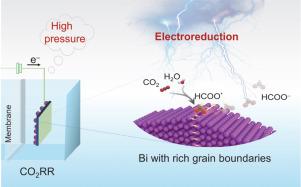Chinese Journal of Catalysis ( IF 15.7 ) Pub Date : 2022-11-09 , DOI: 10.1016/s1872-2067(22)64131-7 Sunhong Ruan , Biao Zhang , Jinhan Zou , Wanfu Zhong , Xiaoyang He , Jinhai Lu , Qinghong Zhang , Ye Wang , Shunji Xie

|
Abstract
Electrochemical CO2 reduction reaction (CO2RR) driven by sustainable energy has emerged as an attractive route to achieve the target of carbon neutral. Formate is one of the most economically viable products, and electrocatalytic CO2RR to formate is a promising technology. High-pressure H-cell electrolyzer is easy to operate and allows high CO2 solubility for realizing high current density, but the design of highly efficient catalysts for working under high CO2 pressures remains challenging. Bismuth-based catalysts exhibit high formate selectivity, but suffer from limited activity. Here, we report a high-performance catalyst, which is derived from BiPO4 nanopolyhedrons during electrocatalytic CO2RR to formate in neutral solution under high CO2 pressures. A high partial current density of formate (534 mA cm−2) and formate formation rate (9.9 mmol h−1 cm−2) with a formate Faradaic efficiency of 90% have been achieved over BiPO4-derived catalyst at an applied potential of −0.81 V vs. RHE under 3.0 MPa CO2 pressure. We discover that BiPO4 nanopolyhedrons evolve into metallic Bi nanosheets with rich grain boundaries in electrocatalytic CO2RR under high CO2 pressures, and the grain boundaries of the BiPO4-derived catalyst play a vital role in promoting electrocatalytic CO2RR to formate. Our theoretical studies reveal that the charge redistribution occurs at the grain boundaries of Bi surface, and this promotes CO2 activation and increases HCOO* intermediate stability, thus making the pathway for CO2RR to formate more selective and energy-favorable. This work not only demonstrates a highly efficient catalyst for CO2RR to formate but also discovers a unique feature of catalyst evolution under high CO2 pressures.
中文翻译:

具有丰富晶界的铋纳米片可在高压下有效地将 CO2 电还原为甲酸盐
摘要
由可持续能源驱动的电化学CO 2还原反应(CO 2 RR)已成为实现碳中和目标的有吸引力的途径。甲酸盐是最经济可行的产品之一,电催化CO 2 RR 制甲酸盐是一种很有前景的技术。高压H电池电解槽操作简单,CO 2溶解度高,可实现高电流密度,但设计在高CO 2压力下工作的高效催化剂仍然具有挑战性。铋基催化剂表现出高甲酸盐选择性,但活性有限。在这里,我们报告了一种源自 BiPO 4的高性能催化剂在高CO 2压力下电催化CO 2 RR 在中性溶液中形成纳米多面体。在BiPO 4衍生的催化剂上,在应用电位为−0.81 V与. RHE 在 3.0 MPa CO 2压力下。我们发现BiPO 4纳米多面体在高CO 2压力下在电催化CO 2 RR中演变成具有丰富晶界的金属Bi 纳米片,并且BiPO 的晶界4-衍生催化剂在促进电催化CO 2 RR 生成甲酸方面起着至关重要的作用。我们的理论研究表明,电荷重新分布发生在Bi表面的晶界处,这促进了CO 2的活化并提高了HCOO*中间体的稳定性,从而使CO 2 RR的生成途径更具选择性和能量优势。这项工作不仅展示了一种高效的 CO 2 RR 甲酸催化剂,而且还发现了在高 CO 2压力下催化剂演化的独特特征。


















































 京公网安备 11010802027423号
京公网安备 11010802027423号